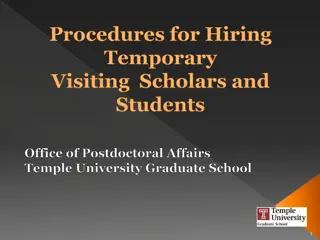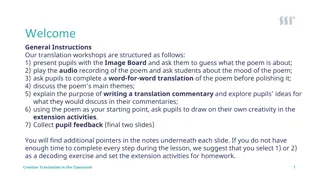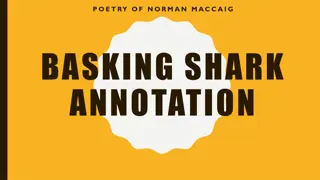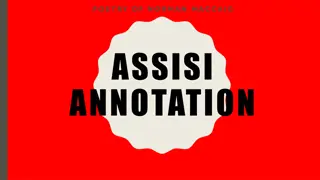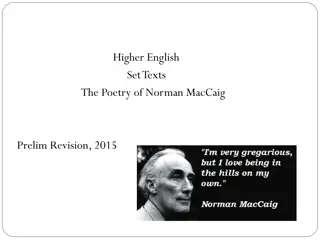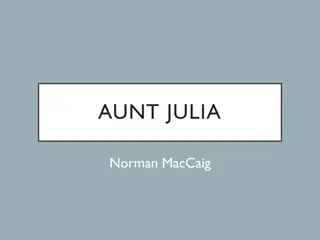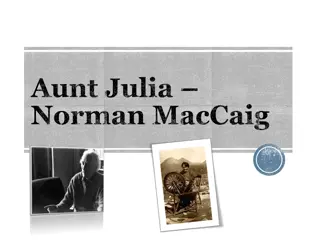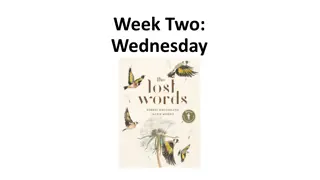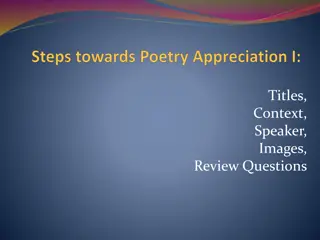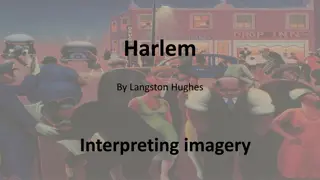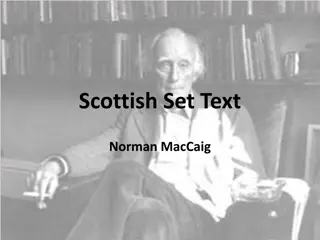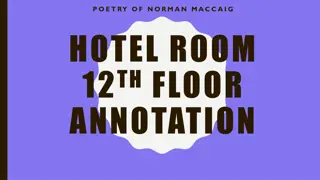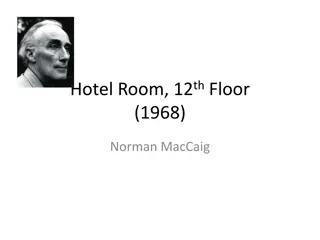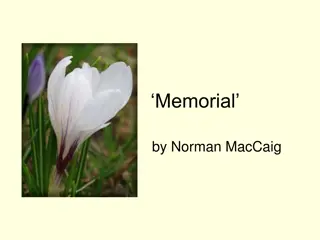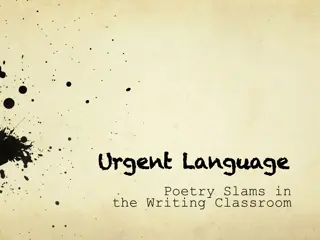Exploring Norman MacCaig's Poem 'Visiting Hour'
The poem "Visiting Hour" by Norman MacCaig portrays a hospital visit to a seriously ill woman, highlighting the fear, anxiety, and emotional distance felt by the poet. Through reflective imagery, MacCaig delves into themes of death, suffering, and the inevitability of facing reality. The structure of the poem mirrors the poet's emotional journey through the hospital, as he grapples with the harsh truths of illness and mortality.
Download Presentation

Please find below an Image/Link to download the presentation.
The content on the website is provided AS IS for your information and personal use only. It may not be sold, licensed, or shared on other websites without obtaining consent from the author. Download presentation by click this link. If you encounter any issues during the download, it is possible that the publisher has removed the file from their server.
E N D
Presentation Transcript
POETRY OF NORMAN MACCAIG VISITING HOUR ANNOTATION
Poets Main Idea This poem describes a hospital visit that MacCaig makes to a seriously ill female friend or relative. He reveals the fear and anxiety that haunts him at the start of the visit He also explores the pain and suffering of the woman he is visiting and shows that they are distanced due to the pain that she is in. At the end of the poem there is a hopeless or despairing tone as he knows he can t help her in the way he would like.
Reflective Nature of the Poem In the interview A Metaphorical Way of Seeing Things , MacCaig maintained that poetry is a psychological Optrex, it clears your eyes and you see things . MacCaig reflects throughout the poem on the ways that people try to distract themselves from death and illness and how this is futile.
Theme Reflection on death and how we try to escape it by distracting ourselves but ultimately we have to face the reality of it. Death is inevitable He also focusses on the suffering of the woman patient and how that isolates her from those she loves
Structure Structure mimics his journey through the hospital Begins with him trying to distract himself from the truth of the visit and then reflecting on the illness once he is confronted by it.
Stanza One The hospital smell combs my nostrils as they go bobbing along green and yellow corridors. Think about: - What happens in this stanza? - Why do you think the poet concentrates on the smell? - What is suggested by the description of the hospital?
Stanza One A universal smell something everybody will recognise Establishes setting/know visiting someone ill Metaphor emphasises strong smell and discomfort Synecdoche - All other senses are blocked The hospital smell combs my nostrils as they go bobbing along green and yellow corridors. Creates humorous picture he is trying to distract himself from visit Bobbing also has connotations of lost/unsure/cast adrift Helps reader picture hospital Word Choice has connotations of sickness/illness Can t escape the fact that he is in hospital
Stanza Two What seems a corpse is trundled into a lift and vanishes heavenward. . Think about: - What happens in this stanza? - What words or phrases could be shocking to the reader? - What is the effect of this image?
Stanza Two Unsure of what he sees/shows his distress Brutal description of body shows finality of death/ Death is in his thoughts What seems a corpse is trundled into a lift and vanishes heavenward. Disappears and doesn t come back as when someone dies Word is emphasised. Shows the inevitability of death Word Choice Slow moving/moving something heavy Enjambment is used to emphasise three words. An attempt at humour but also shows his thoughts are focussed on death
Stanza Three I will not feel, I will not feel, until I have to. . Think about: - What is the poet wanting to do in this stanza? - What emotion is the poet feeling?
Stanza Three Repetition of I shows his determination to not feel Repetition makes statement feel like a mantra or chant he is determined to put off his feelings about what is happening I will not feel, I will not feel, until I have to. Is on a separate line (highlighted by enjambment) reveals that he is aware that he will have to address his feelings can t escape what is happening
Stanza Four Nurses walk lightly, swiftly, here and up and down and there, their slender waists miraculously carrying their burden of so much pain, so many deaths, their eyes still clear after so many farewells. Think about: - What is happening in this stanza? - How does the poet describe the nurses? - What is the poet s feeling towards the nurses?
Stanza Four Word Choice Move elegantly and with purpose Syntax reveals the fact that the nurses move quickly and are everywhere. The repeated use of and reinforces this Nurses walk lightly, swiftly, here and up and down and there, their slender waists miraculously carrying their burden Shows awe at what they do they are like angels coping with their jobs Poet feels envy because he can not do the same Shows amazement that nurses can cope with so much Contrast to slender Reveals weight of what they do/something to endure
Stanza Four Lists the what they have to cope with repetition highlights the amount they deal with in contrast to MaCaig who can t deal with one ill person Nurses don t show any emotion despite the pain and suffering that they see/experience of so much pain, so many deaths, their eyes still clear after so many farewells. Euphemism for death showing that he can t escape these thoughts of death and dying
Stanza Five Ward 7. She lies in a white cave of forgetfulness. A withered hand trembles on its stalk. Eyes move behind eyelids too heavy to raise. Into an arm wasted of colour a glass fang is fixed, not guzzling but giving. And between her and me distance shrinks till there is none left but the distance of pain that neither she nor I can cross. Think about: - What is happening in this stanza? - How does the poet describe the woman? - What emotion do you think the poet is feeling?
Stanza Five Non-sentence. Caesura. Turning Point He (and the reader) shocked by ward He has to face his feelings Metaphor Bed/illness has isolated her and made her forget. Contrast to colours of before highlights her isolation Ward 7. She lies in a white cave of forgetfulness. A withered hand trembles on its stalk. Word Choice Decay/dry /shrivelled up/losing life Metaphor of flower usually romantic but now emphasises the illness of the woman She is weak due to illness Impersonal pronoun body as empty shell
Stanza Five Emphasises illness/medication she is taking she is unable to focus on the visit Eyes move Word Choice description of her body due to illness behind eyelids too heavy to raise. Into an arm wasted of colour a glass fang is fixed, not guzzling but giving. Shocking imagery connotations of a vampire. Highlights distress of poet seeing the woman in this way. Alliteration of f emphasises that it is fixed in place Guzzling emphasises the negative impression of the needle Harsh G sound reveals his feelings pointless and intrusive even as it helps her.
Stanza Five Walking to the hospital bed wanting to be close to her And between her and me distance shrinks till there is none left but the distance of pain that neither she nor I can cross. Metaphor sense of futility physical and emotional pain is a barrier to her connecting with people
Stanza Six She smiles a little at this black figure in her white cave who clumsily rises in the round swimming waves of a bell and dizzily goes off, growing fainter, not smaller, leaving behind only books that will not be read and fruitless fruits. Think about: - What is happening in this stanza? - What point of view is this stanza written in? - What is the final mood or emotion?
Stanza Six His visit has brought her some comfort . It is not clear if she recognises him (black figure) Repetition of cave imagery reinforces isolation Contrast between black and white highlights their differences Black connotations of death, shows how ill she is/MacCaig is worried that she might die. She smiles a little at this black figure in her white cave who clumsily rises in the round swimming waves of a bell Word Choice He is overcome by the experiences Synaesthesia Less obtrusive than other senses gentler sound Time going slower as he prepares to leave?
Stanza Six Vision blurs due to illness Also reinforces image if poet being clumsy due to distress he feels and dizzily goes off, growing fainter, not smaller, leaving behind only books that will not be read and fruitless fruits. Bitter despair and hopelessness Use of enjambment to focus on final image Oxymoron fruitless fruits. Inability to help and so brings gifts that are useless He is helpless in the face of illness and death
An Overview of the Stanzas Stanza One MacCaig describes the smell of the hospitals first hint at illness Stanza Two Tries to distract himself but reality of what he is doing influences what he sees Stanza Three Desperately tries to avoid any emotion Stanza Four Admires the nurses because they do what he can t Stanza Five Reality hits (turning point of the poem. Shows the pain and suffering of the woman Stanza Six End of a hopeless and pessimistic tone. He cannot help the woman
Revision Tasks To help you remember the key points of the poem you should: Write a summary of the poem showing how the poet moves from denying to facing his feelings Identify a key quote for each of the following points: A way in which the poet tries to distract himself His admiration of the nurses His shock and horror at seeing the woman The hopelessness and despair he feels. Write down and analyse any images used

 undefined
undefined








